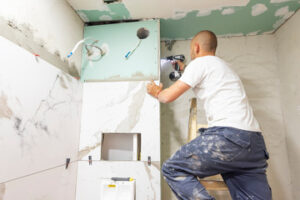Bathroom Remodel Jacksonville FL requires careful planning to ensure the project stays within budget. From the region where you live to unforeseen repairs, there are many factors that can affect your renovation costs.

Avoiding common pitfalls like skimping on materials can save you time and money in the long run. However, it’s essential to select quality materials that are durable enough for the space.
When undergoing a home improvement project, it’s important to understand the factors that impact your budget. This helps you determine where to splurge and where to save. One of the most important aspects is labor costs. This can add up quickly, especially if you need to hire professionals for more complex work such as plumbing or electrical work.
One of the most common bathroom remodeling mistakes is not having an accurate budget. This can lead to overspending and unnecessary expenses. Aim to get your budget set in stone from the start so that you know what to expect.
It’s also helpful to consider the scope of your remodel. A small half bath may only need a refresh, but a large master suite might require an overhaul that could drive up your costs. Once you’ve established your goals, it’s easier to stick to them throughout the remodel process.
Bathroom remodels aren’t the cheapest room in the house, but you can often get a good return on your investment. This is especially true if you choose quality fixtures and materials that will last for a long time. This can help you increase the resale value of your home and make it more attractive to potential buyers.
When it comes to bathroom remodeling, the most important thing is to keep in mind the big picture. Be sure to include all of the costs associated with your project, including labor, materials, and permits. Also, remember that any changes to your bathroom must comply with building codes. For example, the first four feet of your drywall must be moisture and mold resistant. Also, don’t forget to mark the location of your plumbing and electrical hookups before tearing up walls.
Design
The design phase of a bathroom remodel is when you decide what changes are needed to achieve the look and functionality you want. The best way to do this is by creating a plan and taking measurements of the space. Then, you can start choosing materials and products. It’s also a good idea to set a budget. This will help you avoid overspending on materials and labor. It’s a good idea to include a contingency fund of 10-15% of the total project cost to cover unexpected expenses during the remodel.
It is important to consider the reason for your bathroom remodeling. Maybe you are looking to upgrade your bathroom for resale, or maybe you just want to make it more functional. In any case, careful planning and expert guidance can ensure a successful remodel that enhances the value of your home.
A bathroom remodel can be as simple or as complex as you want it to be. A simple cosmetic change like a new paint job or a new shower curtain can give your room a fresh new look. On the other hand, a major renovation could involve adding a bathtub or shower, changing the floorplan, or increasing storage space. A complete redesign is a great way to add new life to your bathroom and increase its value at the same time.
During the remodeling process, it’s essential to choose quality materials and energy-efficient upgrades. This will save you money on utility bills and help protect the environment. For example, a new tub or shower with a low-flow showerhead and dual flush toilet will save water and electricity. You can also save money and energy by installing a tankless water heater.
Materials
A bathroom renovation requires a variety of materials, from flooring and paint to fixtures and appliances. Each material contributes to the overall aesthetic and functionality of the space. Choosing durable, low-maintenance materials reduces future repair costs and extends the lifespan of your remodel. Non-porous surfaces like glazed tiles and quartz countertops resist staining, while easy-to-clean faucets and toilets minimize soap scum buildup. Choosing energy-efficient lighting and water-saving shower and sink fixtures further cuts your utility bills and boosts sustainability.
The purpose of your bathroom remodel determines which materials to select. If your goal is to create a relaxing oasis, consider incorporating natural stone and wood elements. Alternatively, a guest bath can benefit from high-end fixtures and finishes that appeal to buyers. If you’re thinking of selling your home, selecting modern finishes will increase resale value.
For example, swapping out a bathtub for a walk-in shower is a cost-effective and stylish update. Adding storage with built-in shelves and recessed cabinets maximizes your space and helps keep the room clean and organized. Adding a window encourages ventilation, which prevents mildew and mold buildup and extends the life of your new materials.
It’s important to understand the level of maintenance that each material requires before making a final decision. Bathrooms are constantly exposed to moisture, so selecting materials that are resistant to stains and moisture is vital. Porcelain tile, ceramic tile and quartz countertops are all good choices for flooring, walls and counters. These durable materials come in a range of styles and colors to suit any design. Similarly, choosing a low-VOC paint reduces VOC emissions and limits the impact on indoor air quality.
Permits
While permits might seem tedious or unnecessary, they play a vital role in ensuring your home renovation is up to code. They uphold safety standards and ensure that any structural, plumbing, or electrical changes meet NYC’s strict criteria. Moreover, they prevent potential legal issues and fines while safeguarding the health and well-being of your family.
A permit is required for any construction work that alters the interior layout of your home, including a bathroom remodel. However, determining whether your project requires a permit is a complex process that depends on a variety of factors. Licensed contractors are familiar with local codes and can guide you through the permitting process. They can also provide expert advice on materials, ensuring that your remodel is both functional and attractive.
There are some common renovations that don’t require a permit, such as painting walls or replacing fixtures without moving them. However, most electrical or plumbing renovations will require a permit. Additionally, removing walls or modifying a load-bearing wall will require a permit.
The first step is document preparation and submission to the DOB. This includes compiling detailed plans, project descriptions, and any required documentation. Thorough and accurate documentation is key to a successful permit application. The DOB will review your application and make sure it meets all regulatory requirements.
While obtaining a permit may seem daunting, it is essential for the success of your bathroom remodel. Failure to comply with regulations could lead to expensive fines or even a complete building failure. In addition, if your property is located in a historic district or landmark, you may need to obtain additional approvals from the Landmark Preservation Commission (LPC). Therefore, working with a qualified and experienced contractor who understands NYC’s regulations is highly recommended.
Contractors
When planning your bathroom remodel, it’s important to hire a contractor that will help you meet your goals within a realistic timeframe and budget. A professional can also offer insight into potential changes that you may not have considered. It’s a good idea to set a clear budget and get multiple quotes before starting the project. It’s also a good idea to include a contingency of 5-10% in your budget for unforeseen expenses.
A bathroom renovation is a great way to revive your space and add value to your home. It’s also an excellent opportunity to make energy-efficient improvements like water-saving toilets and low-flow showerheads. This will increase the comfort of your bathroom and reduce your utility bills.
Another option is to replace existing fixtures and materials with new ones, such as a new vanity, bathtub, or shower. This type of remodeling is typically less expensive than a full remodel because it doesn’t require changing the existing layout or moving plumbing fixtures.
Before hiring contractors, review their portfolios and ask for a list of past projects. You should also check their credentials and licenses to ensure they are qualified and insured. A long track record is often a sign of experience and reliability. It’s also a good idea ask for references and referrals from friends and family members. This will give you a better idea of the contractor’s quality of work and customer service.
